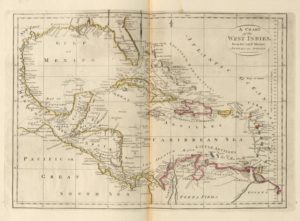West Indies

Lionel Pincus and Princess Firyal Map Division, The New York Public Library. “A chart of the West Indies, from the latest marine journals and surveys” The New York Public Library Digital Collections. 1814. http://digitalcollections.nypl.org/items/510d47e1-cba1-a3d9-e040-e00a18064a99
Joe came over to the bed. He took hold of my hand and stroked it. I said, ‘I know what you’re going to say. You’re going to say it’s cold and clammy. Well, it’s because I was born in the West Indies and I’m always like that.’ (124)
Here we see Anna get to the bottom of why she is always cold throughout the book. She explains that she is from the West Indies which has a warm climate. She doesn’t state which country she’s from when Joe mentions possible countries. She gives the clue that it is a smile island and that’s it. Her always reminiscing the west indies made me interesting in what was going on in the West Indies during the time she left. According to an article I found during that time the main focus of finding one’s identity and establishing the social group they belong to was very important. The working-class workers were getting prepared for employment changes during this time. The Bolshevik Revolution that happened in 1917 actually helped to enforce this. It was also said that a block dock worker from Guyana which use to be called “British Guiana” started the Modern trade union where he joined protest of the labor changes and used his () to organize urban workers. By 1919 he was able to create a “British Guyana Labour Union”. Based on the article I read it seems as if Anna left because her parents were perhaps thinking that changes such as the one’s stated above would be coming amongst there country soon. They were apart of the working class and maybe didn’t want Anna to have to deal the struggles that were coming their way. Unfortunately, we see Anna did not live the life I imagined her parents had predicted for her.
Hintzen, Percy C. “Reproducing Domination Identity and Legitimacy Constructs in the West Indies.” Social Identities, vol. 3, no. 1, 1997, pp. 47–76., doi:10.1080/13504639752168.


